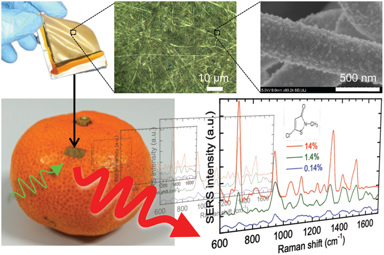 [Enlarge image]Top: Schematic of the flexible gold nanomesh substrate. Bottom: Place & Play SERS measurement scheme, involving the placement of the gold nanomesh substrate on an object of interest for conducting in situ measurements.
[Enlarge image]Top: Schematic of the flexible gold nanomesh substrate. Bottom: Place & Play SERS measurement scheme, involving the placement of the gold nanomesh substrate on an object of interest for conducting in situ measurements.
The ability to conduct highly sensitive, real-time, on-site and multiplexed chemical analyses is crucial in various fields, from health monitoring and food safety to forensic research and environmental surveillance. Surface-enhanced Raman spectroscopy (SERS) stands out in this regard, by virtue of its exceptional sensitivity and rapid, label-free detection, and the compactness of wearable-sized Raman spectrometers.
However, the practical application of SERS is often constrained by the need to obtain a sample and place it on a SERS substrate for analysis. This method of sample collection can be laborious, costly and sometimes hazardous.
To address these challenges, we present our novel “Place & Play SERS” concept,1 which uses an ultrathin, flexible, stretchable, adhesive and biocompatible gold-deposited polyvinyl alcohol nanomesh substrate based on a breakthrough we previously achieved.2 This substrate can be applied directly onto the subject, facilitating SERS measurements without causing any damage or requiring physical contact with the object.
We validated this approach with two key demonstrations. First, we used it to detect biocides on fruit after harvesting to check their food safety. Second, we identified abused drugs on surfaces commonly in contact with drug-laden hands for forensic purposes.1 Intriguingly, the obtained Raman spectra were not from the main object but rather from its surface, ensuring that the measurements were specific to the subject of interest through SERS.
Our results highlight the transformative potential of this innovative SERS technique, which we believe could open doors to a myriad of applications for in-depth, real-time and on-site chemical analyses.
Researchers
Yasutaka Kitahama, Ting-Hui Xiao and Keisuke Goda, The University of Tokyo, Tokyo, Japan, and LucasLand, Tokyo, Japan
Pablo Martinez Pancorbo, The University of Tokyo, Tokyo, Japan
William Yang, BaySpec, San Jose, CA, USA
References
1. Y. Kitahama et al. Anal. Methods 15, 1028 (2023).
2. L. Liu et al. Adv. Opt. Mater. 10, 2200054 (2022).
